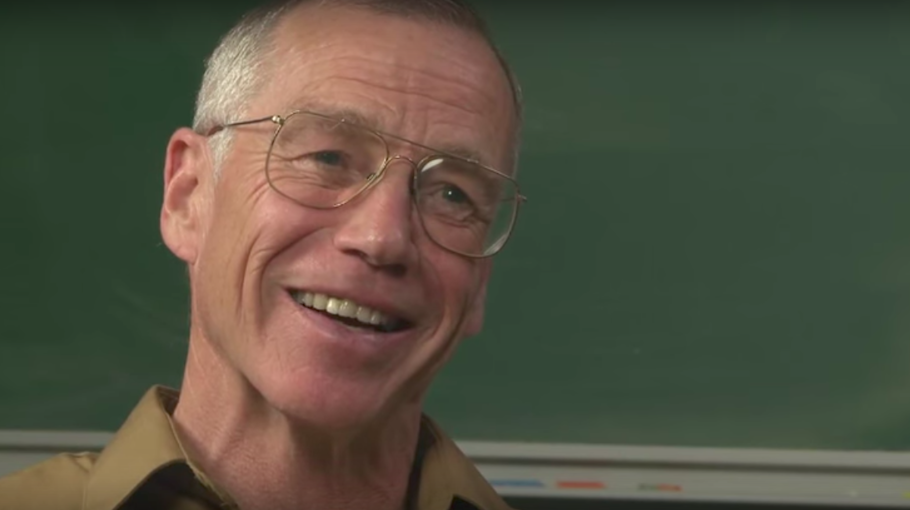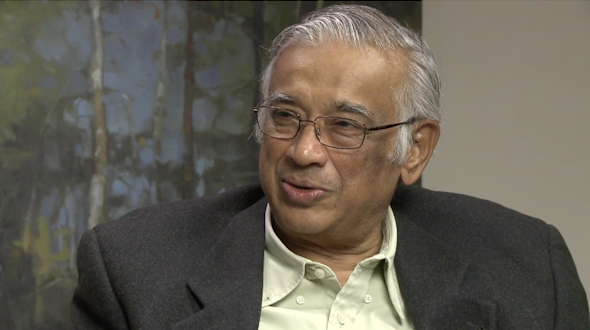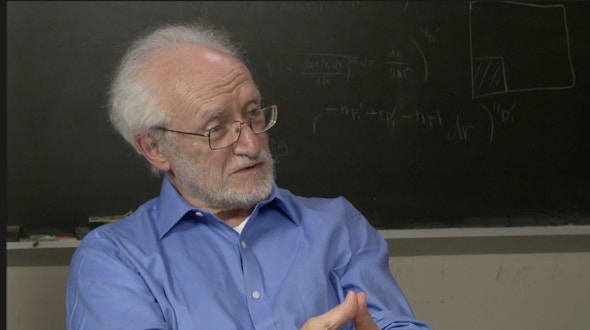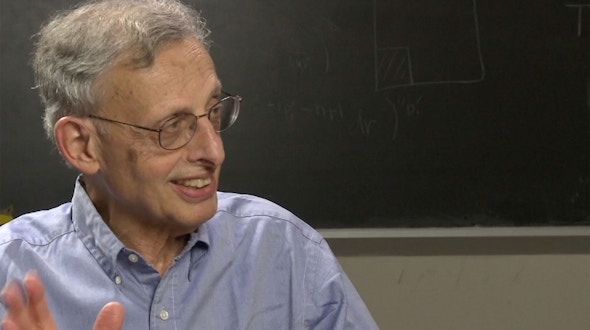Michael Freedman
- Highlights (4:23)
- A family of prodigies (7:38)
- Upbringing and college (7:16)
- Princeton application (5:21)
- Arriving at Princeton (3:59)
- Work on Foliations and Completion of Thesis (4:09)
- Kirby Notes and Casson Handles (5:55)
- Understanding four (3:56)
- The Topology of Four (4:35)
- Bob Edwards (2:16)
- Moving towards Quantum computing (10:52)
- Work at Microsoft Research and establishing Station Q (6:17)
- Quantum computing (5:10)
- Current Research (5:29)
By his family’s standards, Michael Freedman might be considered a bit of a slouch. The Fields Medal, the National Medal of Science and a MacArthur Foundation fellowship are all very well, but they don’t erase the fact that he completed high school at the ripe old age of 17 — four years older than his father, Ben Freedman, and five years older than his uncle, David Freedman. Toby Freedman, the only uncle who took nearly as long as Michael, was known affectionately in his family as “Toby the Dope.”
“I was aware of how slow I was,” Freedman says.
But if the family atmosphere was a bit intimidating at times, it was also highly stimulating. Freedman’s father was a recreational mathematician (who later earned a doctorate in the subject), and by the time Freedman finished high school, he had caught his father’s love of mathematics research. “I don’t think one in a hundred freshmen has any idea what a mathematician spends his time doing, but I did, because of my father,” he says.
At his mother’s suggestion, however, Freedman started college at the University of California, Berkeley, with the intention of majoring in art, despite nagging concerns about whether this goal was a good fit.
“I was troubled, for example, by the fact that the size of a picture affects its impact,” Freedman recalls. “If I was going to devote myself to art, I wanted to make sure it would really mean something. I wanted to know the difference between a good painting and a bad one, and that fact that I couldn’t answer why size was important made me feel it was rather arbitrary.”
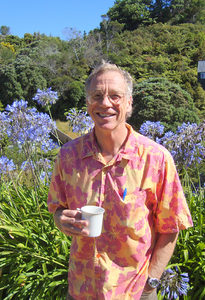
After an unproductive meeting with the art department’s chair, Freedman chose to major in mathematics. Since he came from a family of prodigies, he decided that he could skip the first-year calculus course and its allied subjects, such as differential equations. Instead, he enrolled directly in upper-level courses in abstract algebra, topology and measure theory, a decision that influenced the direction of his research for years to come.
Already, Freedman was ambitious. “I knew I had uneven abilities and I didn’t understand large swaths of mathematics,” he says. “But I felt that in certain areas I could concentrate very well and see things other people didn’t see, and I thought that if I found the right problem, I could do something important in mathematics.”
Freedman found himself stymied by the math department’s language requirement, however. After just a year, he entered the graduate program at Princeton University, whose language requirements were less rigid.
Freedman was less than ideally prepared for graduate school, even though he had spent much of the drive from California to New Jersey with a math textbook propped open on the steering wheel. In his first class at Princeton, Freedman recalls, his professor, Donald Spencer, opened by saying, “Let S be the sheaf of germs of sections of a vector bundle.” Freedman thought to himself, ”Well, good, I know what a vector is.”
Within three years, however, Freedman had completed a dissertation under the direction of Bill Browder in the field of topology, which studies the properties of a shape that remain unchanged if the shape gets stretched or distorted. Unfortunately, however, Freedman learned that another mathematician had proved the same result. On Browder’s advice, Freedman spent one additional year in graduate school. “That was actually the best decision I ever made,” Freedman says. “It was in that fourth year of graduate school that things started to make sense. Instead of being in a lecture and understanding 10 percent, all of a sudden I understood 90 percent.”
***
After graduating, Freedman took on visiting positions at Berkeley and the Institute of Advanced Study in Princeton before accepting a tenure-track job at the University of California, San Diego.
Robion Kirby, a mathematician at Berkeley, recalls thinking at the time that Freedman was a little lucky to get the job in San Diego, since he didn’t have a big track record yet. The Berkeley math department, which had chosen not to offer Freedman a tenure-track job, had no idea what lay in Freedman’s future, Kirby says.
While at Berkeley, Freedman had become captivated by the ideas of Andrew Casson, who set forth an infinite process for constructing handle-like structures within four-dimensional shapes, or “four-manifolds.” Even though four-manifolds can’t be visualized nearly as easily as three-dimensional shapes, they have long been favorites of Freedman, who calls four “the most interesting dimension.”
In dimensions three and lower, he observes, the topology of a shape is largely dictated by considerations from geometry, which complements topology by studying the attributes of a shape that do change when the shape gets distorted, such as lengths and angles. In dimensions five and higher, by contrast, a shape’s geometric type no longer significantly restricts the possibilities for its topology.
“Dimension four is exactly where geometry and topology are starting to tear away from each other, which leads to very beautiful and complicated subjects on both sides,” Freedman says.
Freedman felt convinced that Casson’s construction could be pushed much further, to shed additional light on four-dimensional shapes. For the next seven years, he spent about half of his time working on this challenging research project, spending the rest of his research hours on surer bets.
By 1981, Freedman had succeeded in using Casson’s framework to produce what is now considered one of the cornerstones of the theory of four-manifolds: a complete classification of compact four-manifolds that have no holes of a particular type. In particular, his result proved the four-dimensional version of the famous Poincaré conjecture. This version states, roughly speaking, that any compact four-manifold that can be gradually bent, contracted and expanded into a four-dimensional sphere is in fact topologically the same as the four-dimensional sphere.
At first, Freedman recalls, his results seemed too good to be true. “It took several weeks for me to be convinced that the story held together,” he says.
Freedman presented his findings at a conference in the summer of 1981. Kirby, who was in the audience, remembers thinking, “How did he ever get the nerve to make this announcement? Because he can’t be positive about this crazy argument.”
Electrified by Freedman’s announcement, a group of experts lingered at the conference site for about a week, picking apart the details of his argument. By the end of the week, they had arrived at a verdict: The theorem was correct.
Freedman’s work, for which he was awarded a Fields Medal in 1986, comprised one audacious step after another, Kirby says. The result was “the single best piece of mathematics that I was aware of,” Kirby says. “Bar none.” If Freedman hadn’t seen how to work through the different chunks of his argument, according to Kirby, his classification result might well still be an open problem today, more than three decades later.
***
After achieving his landmark result, Freedman decided to go back and fill in the gaps in his mathematical education. “After I got the Fields Medal, I was viewed as somehow representing mathematics, and it was a little silly not to know any, so to speak,” he says.
Such self-deprecating remarks are typical of Freedman, comments Kevin Walker, who collaborates with him at Microsoft Station Q in Santa Barbara, California. “He is very generous with praise for other mathematicians,” Walker says. “But if you try to pay him a compliment, he will quickly deflect it.”
Freedman became a fount of insight and information, Walker says, both because his interests became so broad and because he had a knack for getting to the heart of a subject. “If you wanted a five-minute summary of a 60-page paper, I don’t know anyone better than Mike for saying, ‘Here are the core ideas of the paper,’” Walker says.
In 1988, Freedman attended what he calls a life-changing seminar at Harvard University on the recent work of Edward Witten (now at the Institute for Advanced Study in Princeton), who linked the topological theory of knots and links to an area of physics now known as topological quantum field theory. Freedman had recently learned that calculating the “Jones polynomial” of a knot or link is an extraordinarily hard computational problem, but one whose solution would in turn provide solutions to many other hard computational problems. Witten’s work seemed to suggest that certain physical systems calculate Jones polynomials instantaneously.
“I was immediately fascinated with the idea that you should try to build a computer that was based on whatever physics Witten was talking about, and then it would be able to solve these marvelously complicated problems,” he says.
Freedman dived into the subject over the decade that followed, painstakingly studying the relevant physics. “I still speak physics with an accent,” he says.
Freedman’s graduate students got to witness this process of self-education firsthand, recalls Slava Krushkal, a former Freedman student now at the University of Virginia. Freedman held four topology and physics seminars each week for his graduate students, during which he would often lecture about whatever he was working on at the moment. “He would think about something and then he would give a lecture — it wasn’t always correct, but it was a great way to see how someone like Mike thinks about things,” Krushkal says.
In 1997, Freedman accepted a job at Microsoft, and since 2005 he has directed Station Q, a Microsoft outpost dedicated to research in topological quantum computing.
“I don’t know many mathematicians who, late in their career, will decide to learn another field,” Walker says. “Most mathematicians, once they become expert in something, stay there because they’ve invested a lot of time, and why go back to square one?”
Unlike many mathematicians, Krushkal says, Freedman is not interesting in latching onto a subject and writing lots of technical papers extending the field’s techniques a bit further. Instead, “his style is to come up with very original ideas,” Krushkal says. “It’s the opposite of incremental.”
Freedman is an avid rock climber and mountaineer, and stories abound of his daring — but always carefully considered — exploits.
“On at least three occasions I can think of, he has snapped tendons just by straining too hard,” says Walker, who has joined Freedman on many outdoor adventures. “His outdoors personality is a mirror of his math personality, which is very tenacious.
“Climbing with him is very safe when it comes to things that might kill you, but when it comes to things that might make you cold or sore or uncomfortable, that doesn’t count much for him,” Walker adds. “He just proceeds with the goal of getting to the top.”
